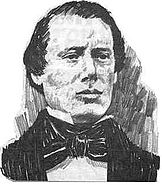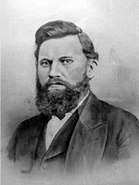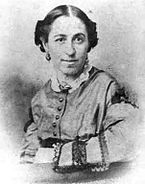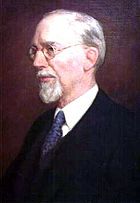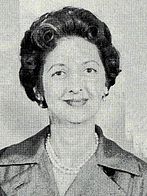
Hyrum Smith was an American religious leader in the Church of Jesus Christ of Latter Day Saints, the original church of the Latter Day Saint movement. He was the older brother of the movement's founder, Joseph Smith, and was killed with his brother at Carthage Jail where they were being held awaiting trial.

Joseph Smith Sr. was the father of Joseph Smith Jr., the founder of the Latter Day Saint movement. Joseph Sr. was also one of the Eight Witnesses of the Book of Mormon, which Mormons believe was translated by Smith Jr. from golden plates. In 1833, Smith Sr. was named the first patriarch of the Church of Christ. Joseph Sr. was also a member of the First Presidency of the church.
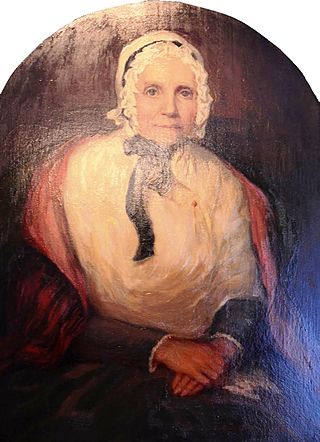
Lucy Mack Smith was the mother of Joseph Smith, founder of the Latter Day Saint movement. She is noted for writing the memoir, Biographical Sketches of Joseph Smith, the Prophet, and His Progenitors for Many Generations and was an important leader of the movement during Joseph's life.
Lineal succession was a doctrine of the Latter Day Saint movement, whereby certain key church positions were held by right of lineal inheritance. Though lineal succession is now largely abandoned, the offices connected with the practice were the President of the Church and the Presiding Patriarch.
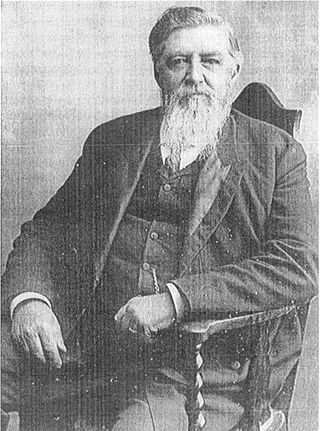
Alexander Hale Smith was the third surviving son of Joseph Smith and Emma Hale Smith. Smith was born in Far West, Missouri, and was named after Alexander Doniphan, who had refused an order to execute Joseph Smith, and then was Joseph's defense attorney during Joseph's incarceration at Liberty Jail. Alexander Smith became a senior leader of the Reorganized Church of Jesus Christ of Latter Day Saints. Smith served as an apostle and as Presiding Patriarch of the church. He became religiously inclined after the April 1862 death of his older brother Frederick G. W. Smith, who had not been baptized, and was baptized on May 25, 1862, in Nauvoo, Illinois, by another older brother, Joseph Smith III.
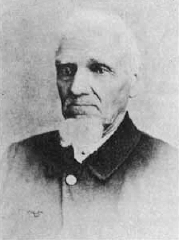
William Smith was a leader in the Latter Day Saint movement and one of the original members of the Quorum of the Twelve Apostles. Smith was the eighth child of Joseph Smith Sr. and Lucy Mack Smith and was a younger brother of Joseph Smith Jr., the founder of the Latter Day Saint movement.
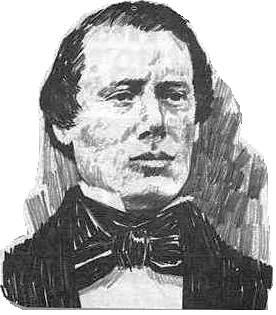
Samuel Harrison Smith was a younger brother of Joseph Smith, founder of the Latter Day Saint movement. Samuel was a leader in his own right and a successful missionary. Smith is commonly regarded as the first Latter Day Saint missionary following the organization of the Church of Christ by his brother, Joseph. One of the Eight Witnesses to the Book of Mormon's golden plates, Samuel Smith remained devoted to his church throughout his life.
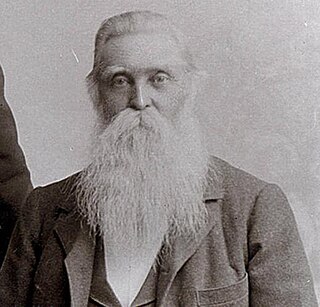
John Smith, was the fifth Presiding Patriarch of the Church of Jesus Christ of Latter-day Saints. His father was Hyrum Smith, the older brother of Joseph Smith, the founder of Mormonism. Having served for 56 years, he was the longest serving Presiding Patriarch in the history of the LDS Church. Smith traveled west to Winter Quarters and then Salt Lake City with the Mormon pioneers. He traveled with Heber C. Kimball's party and his step-mother Mary Fielding Smith. Smith joined the "Battalion of Life Guards" to protect the Latter-day Saints from Native Americans.

Jesse Nathaniel Smith was a Mormon pioneer, church leader, colonizer, politician and frontiersman. He was a member of the Church of Jesus Christ of Latter-day Saints. He was a first cousin to Joseph Smith, founder of the Latter Day Saint movement.
Joseph Smith was an American religious leader and the founder of the Latter Day Saint movement whose current followers include members of the Church of Jesus Christ of Latter-day Saints, the Community of Christ, and other Latter Day Saint denominations. The early life of Joseph Smith covers his life from his birth to the end of 1827.
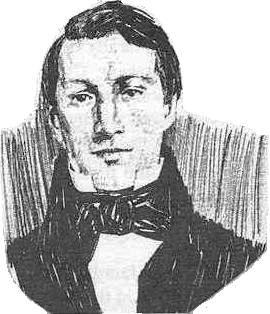
Alvin Smith was the eldest brother of Joseph Smith, founder of the Latter Day Saint movement. Alvin took a leading role in helping the Smith family work toward paying their debts and building their home. His death at age 25 resulted in his younger brothers Hyrum and Joseph taking more of a leading role in family affairs. A vision by Joseph Smith showed Alvin, who was not baptized while alive, in the celestial kingdom, which is the highest of the degrees of glory. His presence in the life of young Joseph Smith and in that vision played a significant role in the establishment of the Latter Day Saint doctrines of redemption of those who die without a knowledge of the gospel, as well as the practice of baptism for the dead in the Church of Jesus Christ of Latter-day Saints.
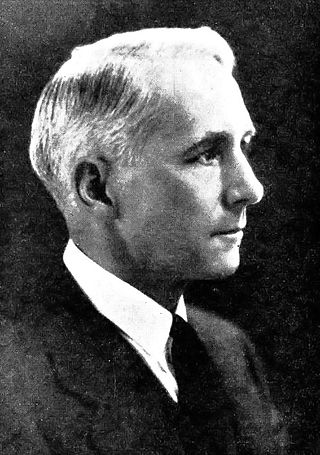
Hyrum Gibbs Smith was Presiding Patriarch of the Church of Jesus Christ of Latter-day Saints from 1912 until his death.
Don Carlos Smith was the youngest brother of Joseph Smith and a leader, missionary, and periodical editor in the early days of the Latter Day Saint movement.
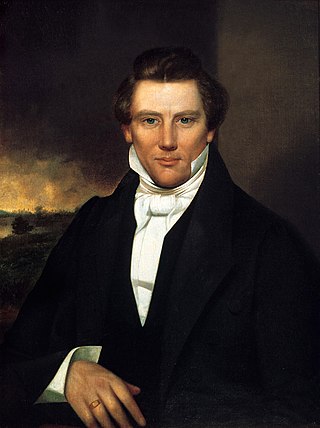
This is a chronology of Mormonism. In the late 1820s, Joseph Smith, founder of the Latter Day Saint movement, announced that an angel had given him a set of golden plates engraved with a chronicle of ancient American peoples, which he had a unique gift to translate. In 1830, he published the resulting narratives as the Book of Mormon and founded the Church of Christ in western New York, claiming it to be a restoration of early Christianity.
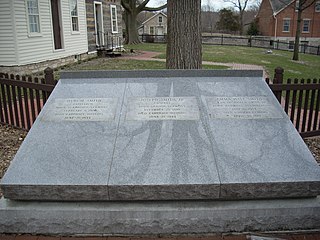
The Smith Family Cemetery, in Nauvoo, Illinois, is the burial place of Joseph Smith, his wife Emma, and brother Hyrum. Joseph Smith's parents Joseph Smith Sr. and Lucy Mack Smith are also buried there, as are Joseph Smith's brothers Samuel and Don Carlos. Others buried there include Robert B. Thompson and Emma Smith's second husband Lewis C. Bidamon.

KatharineSmith Salisbury was a sister to Joseph Smith and an early convert in the Latter Day Saint movement.
Early participants in the Latter Day Saint movement consist of those individuals who were involved in Joseph Smith's Latter Day Saint movement prior to Smith's departure for Ohio in January 1831. Early participants also included the Three Witnesses and the Eight Witnesses to the Book of Mormon and members of the extended Whitmer and Smith families. Other early members included friends and acquaintances of the Smith and Whitmer families, such as Orrin Porter Rockwell.

The following outline is provided as an overview of and topical guide to the life and influence of Joseph Smith:

Lucy Smith Millikin was an American woman who was an early participant in the Latter Day Saint movement and a sister of Joseph Smith. She was the youngest child of Joseph Smith Sr. and Lucy Mack Smith. Millikin joined the Church of Christ when it was organized in 1830, and then moved to Kirtland, Ohio with her family in 1831, where she assisted in the effort to build the Kirtland Temple. After fleeing persecution in Far West, Missouri, she settled in Nauvoo, Illinois. When baptism for the dead was first introduced into the church, Millikin was one of the first Latter Day Saints to participate in the practice. She then joined the Relief Society and served a mission with her husband, Arthur Millikin, in Maine. Millikin chose not to follow Brigham Young and the Mormon pioneers west to Utah Territory, and was instead received into the Reorganized Church of Jesus Christ of Latter day Saints (RLDS) in 1873, though she never became very involved in the church. She died in Colchester, Illinois in 1882, at the age of 61.






